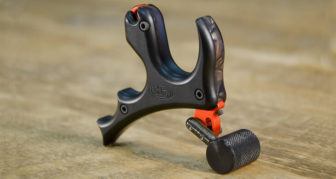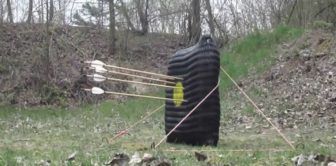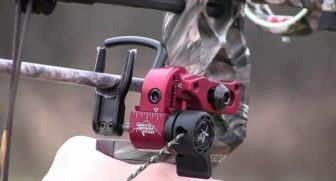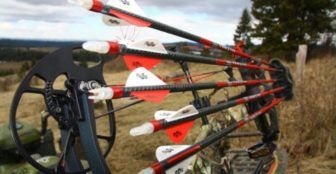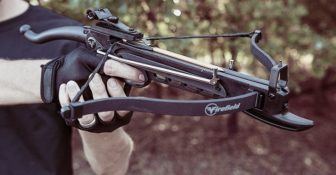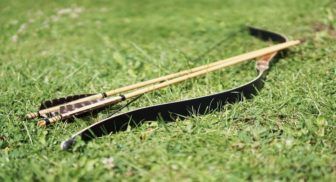5 Important Parts of a Hunting Arrow
Photo: archerybusiness.com
Any hunter can purchase an arrow but not many know what to look out for. An arrow’s anatomy has many variations that affect their effectiveness. This article comprehensively explains the parts of a hunting arrow and the role of each part in hunting.
Parts of Hunting Arrow
1. Arrowhead /Tip
This is the foremost end of the arrow which is what penetrates through a target- game in this case. Some arrowheads are fixed to the arrow while others are removable. This allows the hunter to change between the different arrowhead types.
The first type of arrowhead is the broadheads that have three to four hunting blades and this makes them suitable for taking down larger game.
Some broadheads may be glued to the shaft and are known to be easily susceptible to drag and wind interference. Their accuracy may therefore be affected by the same.
On the other hand, some are removable and they are made to spring open upon impact with the target. Their nature also allows for easy replacement and sharpening of the blades when blunt and thus less effective. This type of arrowhead is, however, fragile and may easily break.
The second type of arrowhead is the field points which are mainly used for practice purposes when one is shooting at a fixed target. Field points can be bought in weights similar to the broadheads to ensure one can practice effectively.
You can use this type of arrowhead to hunt small game but it will not be effective for larger game because the tips have a conical or bullethead shape.
2. Shaft
The shaft is the mid and the longest part of the arrow. Various shaft factors affect the effectiveness of the arrow in hunting in diverse ways.
Weight
Arrow weight is measured in grains per inch (GPI). A light shaft is one with 5-6 GPI and it affects the speed of the arrow because it flies faster with a flatter trajectory. However, this shaft weight is not good in penetration hence is not suitable for the big game.
Midweight shafts weigh between 7 and 9 GPI. Known to be moderate in speed and penetration, this, therefore, makes them good for the medium-sized game and sometimes bigger game when the shafts are drawn correctly.
Heavy shafts are those above 10 GPI are great for large game hunting because the shafts have excellent penetration power. This is even though they fly slower due to their weight.
Spine
The spine is the of the arrow shaft’s flexibility/bend or its stiffness. This consequently affects the number of times the arrow oscillates when fired from a bow which in turn affects its accuracy.
The concept of the archer’s paradox comes into play during firing because an arrow flexes as it leaves the arrow rest and straightens out in flight. Too much or too little flex will affect the arrow’s accuracy. Manufacturers take care of this and match it well with the weight.
Diameter
This is the distance between one side of the round part of the arrow shaft to the other side, through the center. Shaft diameter impacts the speed, therefore, the penetration of the arrow.
Smaller diameter shafts are more streamlined, faster in flight, and have greater penetration. Shafts with bigger diameter have lower penetration potential.
Thickness
The thickness of the shaft is related to the diameter and it has an impact on the spine and the shaft’s weight. Thicker shafts have less spine and more weight.
3. Shaft Inserts
Shaft inserts are accessories made from light metal like brass or aluminum that are installed at the front of the shaft with a threaded aperture.
This is a site where arrowheads are attached to the shaft. They are sold in standard sizes to allow for a great fit in the intended shafts and arrowheads.
4. Fletching
The fletching is located at the rear end of the arrow and it’s made of 3 feathers or synthetic vanes. Two of them are made in the same colour while the remaining one is shaded differently.
The shading is meant to make it distinct because it is the part that faces the hunter in a shooting. The name used for this is the cock feather.
The fletching has an impact on the spin and aerodynamic drag of an arrow and this, as a consequence, improves its stability and accuracy. Some arrows may not come with the fletching but it is easy to install.
5. Nock
The arrow nock is the point that fits/ snaps into the bow’s nocking point. It is made of a plastic cup and is meant to hold the arrow in place while being drawn, before firing.
A good fit between the nock and the nocking point is required for optimal results. A loose fit might make the arrow fall off which too much grip may impact the accuracy of the arrow because it will be held back and cause a delay in the firing.
There are different types of nocks and they are named depending on their method of attachment to the shaft. The Press-fit nocks slide inside the hollow shaft and lock into place while the pin nocks lock onto a pin on the end of the shaft.
Over nocks slide on top of the shaft end holding on tightly, while the conventional nocks fit over different shafts and have a cone-shaped end. Sometimes, the conventional nocks may need to be glued into place for a better hold.
Conclusion
In conclusion, learning the anatomy of the hunting arrow contributes to the understanding of the best features to consider during a purchase. Some important features are the arrowhead, the shaft, and its different characteristics, the fletching, and the nock.
